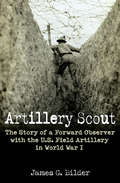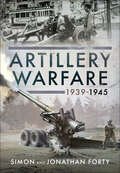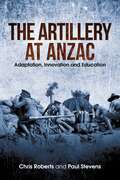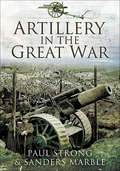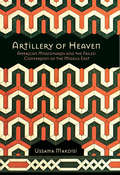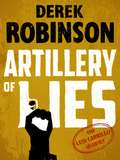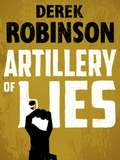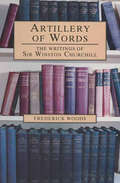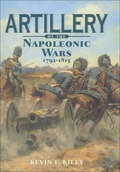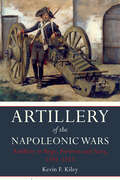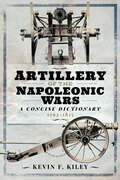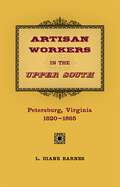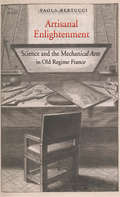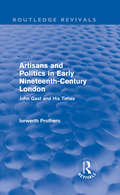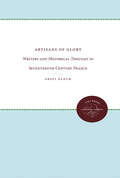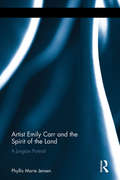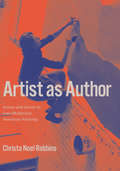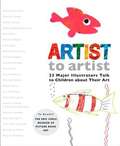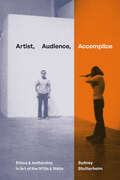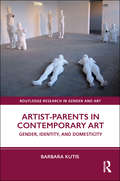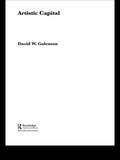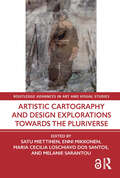- Table View
- List View
Artillery Scout: The Story of a Forward Observer with the U.S. Field Artillery in World War I
by James G. Bilder“Moves quickly; it entertains and provides a decent overview of the life of an American Doughboy” on the Western Front during the Great War (San Francisco Book Review).The American Doughboys of World War I are often referred to as the “Lost Generation”; however, in this book, we are able to gain an intimate look at their experiences after being thrust into the center of Europe’s “Great War” and enduring some of the most grueling battles in US history.Len Fairfield, the author’s grandfather, was an Artillery Scout, or Forward Observer, for the US Army and was a firsthand witness to the war’s carnage as he endured its countless hardships, all of which are revealed here in vivid detail. His story takes the reader from a hard life in Chicago, through conscription, rigorous training in America and France, and finally to the battles which have become synonymous with the US effort in France—St. Mihiel and the Argonne Forest, the latter claiming 26,000 American lives, more than any other US battle.The American Expeditionary Forces endured a rare close-quarters visit to hell until it was sensed that the Germans were finally giving way, though fighting tooth-and-nail up to the very minute of the Armistice. This action-filled work brings the reader straight to the center of America’s costly battles in World War I, reminding us once again how great-power status often has to be earned with blood on battlefields.“All in all, this book is a bit of a gem. It is a well paced easy read and you will find yourself rooting for our hero.” —War in History
Artillery Warfare, 1939–1945
by Simon Forty Jonathan Forty“From mountain warfare with guns on mules to V2 rockets and everything between makes it well worth a place on anyone’s reference shelf.” —Clash of SteelIt is said that artillery won the Second World War for the Allies—that Soviet guns wore down German forces on the Eastern Front, negating their superior tactics and fighting ability, and that the accuracy and intensity of the British and American artillery was a major reason for the success of Allied forces in North Africa from El Alamein, in Italy and Normandy, and played a vital role in the battles of 1944 and 1945. Yet the range of weapons used is often overlooked or taken for granted—which is why this highly illustrated history by Simon and Jonathan Forty is of such value. They stress the importance of artillery on every front and analyze how artillery equipment, training and tactical techniques developed during the conflict.The selection of wartime photographs—many from east European sources—and the extensive quotations from contemporary documents give a graphic impression of how the guns were used on all sides. The photographs emphasize the wide range of pieces employed as field, antiaircraft and antitank artillery without forgetting self-propelled guns, coastal and other heavyweights and the development of rockets. The authors offer a fascinating insight into the weapons that served in the artillery over seventy years ago.“Superbly illustrated, this is testament to the courage and skills of extraordinary men in the execution of their duty. An amazing book.” —Books Monthly
Artillery at Anzac: Adaptation, Innovation and Education
by Chris Roberts Paul StevensA Simon & Schuster eBook. Simon & Schuster has a great book for every reader.
Artillery in the Great War
by Paul Strong Sanders MarbleA year-by-year examination of key WWI battles and how the ongoing advances in artillery shaped strategy, tactics, and oprations; includes battlefield maps! World War I is often said to have been an artillery war, yet the decisive role artillery played in shaping military decisions—and therefor the war itself—has rarely been examined. Artillery in the Great War traces the development of this all-important technology, the differing approaches to its use, the many innovations it underwent on both sides, and how those approaches and innovations in turn effected key battles such as the Battle of the Somme. This highly readable and informative history is perfect for any reader interested in understanding the legacy of World War I, or the evolution of modern warfare.
Artillery of Heaven: American Missionaries and the Failed Conversion of the Middle East (The United States in the World)
by Ussama MakdisiThe complex relationship between America and the Arab world goes back further than most people realize. In Artillery of Heaven, Ussama Makdisi presents a foundational American encounter with the Arab world that occurred in the nineteenth century, shortly after the arrival of the first American Protestant missionaries in the Middle East. He tells the dramatic tale of the conversion and death of As'ad Shidyaq, the earliest Arab convert to American Protestantism. The struggle over this man's body and soul—and over how his story might be told—changed the actors and cultures on both sides. In the unfamiliar, multireligious landscape of the Middle East, American missionaries at first conflated Arabs with Native Americans and American culture with an uncompromising evangelical Christianity. In turn, their Christian and Muslim opponents in the Ottoman Empire condemned the missionaries as malevolent intruders. Yet during the ensuing confrontation within and across cultures an unanticipated spirit of toleration was born that cannot be credited to either Americans or Arabs alone. Makdisi provides a genuinely transnational narrative for this new, liberal awakening in the Middle East, and the challenges that beset it.By exploring missed opportunities for cultural understanding, by retrieving unused historical evidence, and by juxtaposing for the first time Arab perspectives and archives with American ones, this book counters a notion of an inevitable clash of civilizations and thus reshapes our view of the history of America in the Arab world.
Artillery of Lies
by Derek Robinson1943. British Intelligence has finally got to grips with the Eldorado Network, Germany's most successful spy ring. It turns out to be one man in a small room in Lisbon, inventing phony (but convincing) reports. For two years he pulled the wool over German Intelligence's eyes, and made a killing.The British soon find that Eldorado's a real handful. They bring him to England, so they can manage his dispatches, and discover that living with a genius can be a headache. Eldorado rapidly creates a team of top sub-agents around him. None of them exists. But power--even imaginary power--is intoxicating, and he begins to treat his fake sub-agents as if real. Big trouble ahead.Artillery of Lies is the hair-raising sequel to The Eldorado Network, all the more funny for being soundly based on the true story of a real Second World War spy.
Artillery of Lies
by Derek Robinson1943. British Intelligence has finally got to grips with the Eldorado Network, Germany's most successful spy ring. It turns out to be one man in a small room in Lisbon, inventing phoney (but convincing) reports. For two years he has pulled the wool over German Intelligence's eyes, and made a killing. The British soon find that Eldorado's a real handful. They bring him to England, so they can manage his dispatches, and discover that living with a genius can be a headache. Eldorado rapidly creates a team of top sub-agents around him. None of them exists. But power - even imaginary power - is intoxicating, and he begins to treat his fake sub-agents as if real. Big trouble ahead. Artillery of Lies is the hair-raising sequel to The Eldorado Network, all the more funny for being soundly based on the true story of a real Second World War spy.
Artillery of Lies
by Derek Robinson1943. British Intelligence has finally got to grips with the Eldorado Network, Germany's most successful spy ring. It turns out to be one man in a small room in Lisbon, inventing phoney (but convincing) reports. For two years he has pulled the wool over German Intelligence's eyes, and made a killing. The British soon find that Eldorado's a real handful. They bring him to England, so they can manage his dispatches, and discover that living with a genius can be a headache. Eldorado rapidly creates a team of top sub-agents around him. None of them exists. But power - even imaginary power - is intoxicating, and he begins to treat his fake sub-agents as if real. Big trouble ahead. Artillery of Lies is the hair-raising sequel to The Eldorado Network, all the more funny for being soundly based on the true story of a real Second World War spy.
Artillery of Words: The Writings of Sir Winston Churchill
by Frederick WoodsAn analysis of the writings of the iconic twentieth-century statesman from the author of Young Winston&’s Wars. Only a part-time author, Sir Winston Churchill wrote fifty books and over eight hundred feature articles. He even received the Nobel Prize for Literature in 1953. Now, Frederick Woods, an internationally acknowledged expert in the field of Churchillian writings, presents a full-length appraisal of Churchill&’s literary output, while putting the writings in the context of Churchill's public life. Churchill&’s words were weapons, argues Mr. Woods, written deliberately to win a battle, whether that battle was over the future of India, the fate of the freedom-loving world, the rehabilitation of renowned ancestors, or his own fluctuating reputation. In every case Churchill strove mightily to win, and often presented his case with less objectivity than that expected of one popularly considered to be a major historian. Artillery of Words is not only an illuminating and often witty analysis of Churchill&’s writings; it is also an important and revealing contribution to Churchillian studies in general. Praise for Frederick Woods&’s A Bibliography of the Works of Sir Winston Churchill &“[Reveals] a mastery of both research and presentation.&” —Martin Gilbert, bestselling author of Churchill: A Life
Artillery of the Napoleonic Wars, 1792–1815: Volume I - Field Artillery, 1792-1815 (Napoleonic Library)
by Kevin F. KileyAn extensive look at the large-caliber guns of the Napoleonic period, the battles in which they were used, and the important figures in those conflicts. In this heavily researched study, Kevin Kiley examines Napoleon&’s own artillery as well as that employed by his enemies, and he evaluates the gunners&’ contribution to warfare in the period. By looking at particular battles in detail, Kevin Kiley shows just how the effective employment of artillery could tip the scales of victory.Artillery of the Napoleonic Wars reveals much of the technical aspects of gunnery during the period—how guns were placed, their range, what calibers were preferred, how artillery operates. It examines French artillery, including that of the Imperial Guard, and compares it to that of Britain, Russia, and Austria; it also looks at many of the personalities involved and the difference between good gunnery and mediocre artillery. Illustrated with beautiful line drawings and rare contemporary plates, this unique book reveals a whole new dimension to the Napoleonic period. Based on years of research into regulations of the period, eyewitness accounts of artillerymen, and material culled from official reports, this is a definitive account.&“This must undoubtedly become the standard work for anyone interested in the artillery of the period.&” —Waterloo Journal
Artillery of the Napoleonic Wars: Artillery In Siege, Fortress And Navy 1792-1815
by Kevin F. Kiley&“Filled with statistical information on the guns, ammunition, and carriages, used by the armies . . . places the reader on the ground with the gunners.&”—The Napoleon Series Napoleon was an artilleryman before he was an emperor. He understood the power and effectiveness of cannon and their ability to pulverize defenses, reduce fortresses and destroy attacks. In return, the guns won Napoleon battles. This impressive study chronicles the story of the guns and men during the twenty-three years of almost continuous warfare from 1792–1815: from the battlefields of continental Europe to the almost primitive terrain of North America and of the seas, lakes and rivers that connected them. Detailed technical information is accompanied by vivid descriptions which allow the reader to imagine what it must have been liked to maneuver and man the guns in a variety of situations—whether on the march or on the battlefield. Based on years of research into regulations of the period, eyewitness accounts of artillerymen and material culled from official reports, the scope and depth of material will satisfy the serious researcher, while the lively narrative will appeal to the casual reader. &“Kiley&’s research is impeccable and deserves the highest praise. Moreover, he writes in so entertaining a manner that he informs and educates without effort . . . For the enthusiastic student of the attack and defense of fortified places this is an essential book of reference.&”—Fortress Study Group
Artillery of the Napoleonic Wars: Volume I - Field Artillery, 1792-1815 (Napoleonic Library)
by Kevin F. KileyA comprehensive military history reference book exploring all aspects of the artillery used during the Napoleonic Wars.Napoleon began his military career as an artillery cadet and artillery played a fundamental part in all his great battles. Until the Napoleonic Wars artillery had been seen merely as a supporting arm to the infantry, but Napoleon changed everything. He massed his guns in huge batteries to blast holes in his opponent’s line. He even used the artillery to charge the enemy, the gunners galloping up to the enemy to open fire at pointblank range.Napoleon’s opponents did not all follow suit, choosing other tactical deployments. As a result, the Napoleonic era, more than any that preceded or followed it, was one of fascinating artillery maneuvers and critical actions that changed the course of many of the key battles. As the Prussian Field Marshal Blucher once observed, “Against Napoleon you needed guns – and lots of them!”The Napoleonic Wars was also a time of innovation, with the introduction of shrapnel shells and military rockets. This book will examine the artillery arms of all sides from ‘muzzle to butt plate’. As well as the significant artillerymen of the period, the scientists, and innovators, military and civilian—individuals such as Robins, Belidor, Gribeauval and his colleagues, Maritz, Liechtenstein and his collaborators, as well as the du Teil brothers – will all be examined, as will the important battles and sieges, significant memoirs and documents, and artillery terms that soon became part of the military lexicon.Written by the renowned historian Kevin F. Kiley, this will be the definitive book on the subject and will cover all aspects of artillery in the Napoleonic Wars.“This is a wonderfully complete induction into the details of Napoleonic Artillery. As well as defining some of the archaic terms associated with the art of gunnery (note; point blank is not what we mostly believe it to be) it provides background to the careers of the key characters in the science. The book contains many excellent technical drawings to explain, sketches and images to inform and data tables in the appendix to which to refer. Overall, it is an indispensable aid to understanding the artillery of the period.” —Michael McCarthy, battlefield guide
Artisan Workers in the Upper South: Petersburg, Virginia, 1820-1865
by Diane BarnesThough deeply entrenched in antebellum life, the artisans who lived and worked in Petersburg, Virginia, in the 1800s -- including carpenters, blacksmiths, coach makers, bakers, and other skilled craftsmen -- helped transform their planter-centered agricultural community into one of the most industrialized cities in the Upper South. These mechanics, as the artisans called themselves, successfully lobbied for new railroad lines and other amenities they needed to open their factories and shops, and turned a town whose livelihood once depended almost entirely on tobacco exports into a bustling modern city. In Artisan Workers in the Upper South, L. Diane Barnes closely examines the relationships between Petersburg's skilled white, free black, and slave mechanics and the roles they played in southern Virginia's emerging market economy. Barnes demonstrates that, despite studies that emphasize the backwardness of southern development, modern industry and the institution of slavery proved quite compatible in the Upper South.Petersburg joined the industrialized world in part because of the town's proximity to northern cities and resources, but it succeeded because its citizens capitalized on their uniquely southern resource: slaves. Petersburg artisans realized quickly that owning slaves could increase the profitability of their businesses, and these artisans -- including some free African Americans -- entered the master class when they could. Slave-owning mechanics, both white and black, gained wealth and status in society, and they soon joined an emerging middle class. Not all mechanics could afford slaves, however, and those who could not struggled to survive in the new economy. Forced to work as journeymen and face the unpleasant reality of permanent wage labor, the poorer mechanics often resented their inability to prosper like their fellow artisans. These differing levels of success, Barnes shows, created a sharp class divide that rivaled the racial divide in the artisan community.Unlike their northern counterparts, who united as a political force and organized strikes to effect change, artisans in the Upper South did not rise up in protest against the prevailing social order. Skilled white mechanics championed free manual labor -- a common refrain of northern artisans -- but they carefully limited the term "free" to whites and simultaneously sought alliances with slaveholding planters. Even those artisans who didn't own slaves, Barnes explains, rarely criticized the wealthy planters, who not only employed and traded with artisans, but also controlled both state and local politics. Planters, too, guarded against disparaging free labor too loudly, and their silence, together with that of the mechanics, helped maintain the precariously balanced social structure.Artisan Workers in the Upper South rejects the notion of the antebellum South as a semifeudal planter-centered political economy and provides abundant evidence that some areas of the South embraced industrial capitalism and economic modernity as readily as communities in the North.
Artisanal Enlightenment: Science and the Mechanical Arts in Old Regime France
by Paola BertucciA groundbreaking work that places the mechanical arts and the world of making at the heart of the Enlightenment What would the Enlightenment look like from the perspective of artistes, the learned artisans with esprit, who presented themselves in contrast to philosophers, savants, and routine-bound craftsmen? Making a radical change of historical protagonists, Paola Bertucci places the mechanical arts and the world of making at the heart of the Enlightenment. At a time of great colonial, commercial, and imperial concerns, artistes planned encyclopedic projects and sought an official role in the administration of the French state. The Société des Arts, which they envisioned as a state institution that would foster France’s colonial and economic expansion, was the most ambitious expression of their collective aspirations. Artisanal Enlightenment provides the first in-depth study of the Société, and demonstrates its legacy in scientific programs, academies, and the making of Diderot and D’Alembert’s Encyclopédie. Through insightful analysis of textual, visual, and material sources, Bertucci provides a groundbreaking perspective on the politics of writing on the mechanical arts and the development of key Enlightenment concepts such as improvement, utility, and progress.
Artisans and Politics in Early Nineteenth-Century London: John Gast and his Times (Routledge Revivals)
by Iorwerth ProtheroFirst published in 1979, this book was the first, full-length study of working-class movements in London between 1800 and the beginnings of Chartism in the later 1830s. The leaders and rank and file in these movements were almost invariably artisans, and this book examines the position of the skilled artisan in politics. Starting from the social ideals, outlook and the experience of the London artisan, Dr Prothero describes trade union, political, co-operative, educational and intellectual movements in the first forty years of the century. Setting a scene of alternating growth and contraction in trade, successive hostile governments and the increasing articulation of working-class consciousness the author shows that artisans could be no less militant, radical or anti-capitalist than other groups of working class men.
Artisans of Glory: Writers and Historical Thought in Seventeenth-Century France
by Orest RanumRanum analyzes the canons of writing history and describes the lives and achievements of the royal French historiographers. He examines the manner in which these writers described and, in some sense, created the glory that surrounded the lives of the nobility, hoping by so doing to enhance their own glory. Through studying the careers of these men, the author demonstrates how rhetorical, ideological, and social beliefs determined the way history was written.Originally published in 1980.A UNC Press Enduring Edition -- UNC Press Enduring Editions use the latest in digital technology to make available again books from our distinguished backlist that were previously out of print. These editions are published unaltered from the original, and are presented in affordable paperback formats, bringing readers both historical and cultural value.
Artist Animal (Posthumanities #25)
by Steve BakerAnimals have always been compelling subjects for artists, but the rise of animal advocacy and posthumanist thought has prompted a reconsideration of the relationship between artist and animal. In this book, Steve Baker examines the work of contemporary artists who directly confront questions of animal life, treating animals not for their aesthetic qualities or as symbols of the human condition but rather as beings who actively share the world with humanity.The concerns of the artists presented in this book—Sue Coe, Eduardo Kac, Lucy Kimbell, Catherine Chalmers, Olly and Suzi, Angela Singer, Catherine Bell, and others—range widely, from the ecological to the philosophical and from those engaging with the modification of animal bodies to those seeking to further the cause of animal rights. Drawing on extensive interviews he conducted with the artists under consideration, Baker explores the vital contribution that contemporary art can make to a broader conception of animal life, emphasizing the importance of creativity and trust in both the making and understanding of these artworks.Throughout, Baker is attentive to issues of practice, form, and medium. He asks, for example, whether the animal itself could be said to be the medium in which these artists are working, and he highlights the tensions between creative practice and certain kinds of ethical demands or expectations. Featuring full-color, vivid examples of their work, Artist Animal situates contemporary artists within the wider project of thinking beyond the human, asserting art&’s power to open up new ways of thinking about animals.
Artist Emily Carr and the Spirit of the Land: A Jungian Portrait
by Phyllis Marie JensenEmily Carr, often called Canada’s Van Gogh, was a post-impressionist explorer, artist and writer. In Artist Emily Carr and the Spirit of the Land Phyllis Marie Jensen draws on analytical psychology and the theories of feminism and social constructionism for insights into Carr’s life in the late Victorian period and early twentieth century. Presented in two parts, the book introduces Carr’s émigré English family and childhood on the "edge of nowhere" and her art education in San Francisco, London and Paris. Travels in the wilderness introduced her to the totem art of the Pacific Northwest coast at a time Aboriginal art was undervalued and believed to be disappearing. Carr vowed to document it before turning to spirited landscapes of forest, sea and sky. The second part of the book presents a Jungian portrait of Carr, including typology, psychological complexes, and archetypal features of personality. An examination the individuation process and Carr’s embracement of transcendental philosophy reveals the richness of her personality and artistic genius. Artist Emily Carr and the Spirit of the Land provides captivating reading for analytical psychologists, academics and students of Jungian studies, art history, health, gender and women’s studies.
Artist as Author: Action and Intent in Late-Modernist American Painting
by Christa Noel RobbinsWith Artist as Author, Christa Noel Robbins provides the first extended study of authorship in mid-20th century abstract painting in the US. Taking a close look at this influential period of art history, Robbins describes how artists and critics used the medium of painting to advance their own claims about the role that they believed authorship should play in dictating the value, significance, and social impact of the art object. Robbins tracks the subject across two definitive periods: the “New York School” as it was consolidated in the 1950s and “Post Painterly Abstraction” in the 1960s. Through many deep dives into key artist archives, Robbins brings to the page the minds and voices of painters Arshile Gorky, Jack Tworkov, Helen Frankenthaler, Kenneth Noland, Sam Gilliam, and Agnes Martin along with those of critics such as Harold Rosenberg and Rosalind Krauss. While these are all important characters in the polemical histories of American modernism, this is the first time they are placed together in a single study and treated with equal measure, as peers participating in the shared late modernist moment.
Artist as Author: Action and Intent in Late-Modernist American Painting
by Christa Noel RobbinsWith Artist as Author, Christa Noel Robbins provides the first extended study of authorship in mid-20th century abstract painting in the US. Taking a close look at this influential period of art history, Robbins describes how artists and critics used the medium of painting to advance their own claims about the role that they believed authorship should play in dictating the value, significance, and social impact of the art object. Robbins tracks the subject across two definitive periods: the “New York School” as it was consolidated in the 1950s and “Post Painterly Abstraction” in the 1960s. Through many deep dives into key artist archives, Robbins brings to the page the minds and voices of painters Arshile Gorky, Jack Tworkov, Helen Frankenthaler, Kenneth Noland, Sam Gilliam, and Agnes Martin along with those of critics such as Harold Rosenberg and Rosalind Krauss. While these are all important characters in the polemical histories of American modernism, this is the first time they are placed together in a single study and treated with equal measure, as peers participating in the shared late modernist moment.
Artist to Artist: 23 Major Illustrators Talk to Children about Their Art
by David Briggs Kiffin Steurer Patricia Lee Gaucil Courtney PalmerThis gorgeous collection of art (and the artists behind it) includes work by some of the world's most renowned children's book illustrators--Mitsumasa Anno, Quentin Blake, Ashley Bryan, Nancy Ekholm Burkert, Eric Carle, Tomie dePaola, Jane Dyer, Mordicai Gerstein, Robert Ingpen, Steven Kellogg, Leo Lionni, Petra Mathers, Wendell Minor, Barry Moser, Jerry Pinkney, Alice Provenson, Robert Sabuda, Matthew Reinhart, Maurice Sendak, Gennady Spirin, Chris Van Allsburg, Rosemary Wells, and Paul O. Zelinsky. It's a remarkable and beautiful anthology that features twenty-three of the most honored and beloved artists in children's literature, talking informally to children--sharing secrets about their art and how they began their adventures into illustration. An event book for the ages. Proceeds from the book will benefit the Eric Carle Museum of Picture Book Art in Amherst, MA.
Artist, Audience, Accomplice: Ethics and Authorship in Art of the 1970s and 1980s
by Sydney StutterheimIn Artist, Audience, Accomplice, Sydney Stutterheim introduces a new figure into the history of performance art and related practices of the 1970s and 1980s: the accomplice. Occupying roles including eyewitness, romantic partner, studio assistant, and documenter, this figure is situated between the conventional subject positions of the artist and the audience. The unseen and largely unacknowledged contributions of such accomplices exceed those performed by a typical audience because they share in the responsibility for producing artworks that entail potential ethical or legal transgressions. Stutterheim analyzes the art of Chris Burden, Hannah Wilke, Martin Kippenberger, and Lorraine O’Grady, showing how each cannily developed strategies of shared culpability that evoked questions about the accomplice’s various rights and roles. In this way, Stutterheim argues that the artist’s authority is not sovereign, total, or exclusive but, rather, fluid and relational. By examining the development of an alternative model of participatory art that relies on a network of accomplices, Stutterheim radically revises current understandings of artistic agency, aesthetic property, and acknowledged authorship.
Artist-Parents in Contemporary Art: Gender, Identity, and Domesticity (Routledge Research in Gender and Art)
by Barbara KutisThis book examines the increasing intersections of art and parenting from the late 1990s to the early 2010s, when constructions of masculine and feminine identities, as well as the structure of the family, underwent radical change. Barbara Kutis asserts that the championing of the simultaneous linkage of art and parenting by contemporary artists reflects a conscientious self-fashioning of a new kind of identity, one that she calls the ‘artist-parent.’ By examining the work of three artists—Guy Ben-Ner, Elżbieta Jabłońska, and the collective Mothers and Fathers— this book reveals how these artists have engaged with the domestic and personal in order to articulate larger issues of parenting in contemporary life. This book will be of interest to scholars in art and gender, gender studies, contemporary art, and art history.
Artistic Capital
by David GalensonAt what stage of their careers do great artists produce their most important work? In a series of studies that bring new insights and new dimensions to the study of artistic creativity, Galenson’s new book examines the careers of more than one hundred modern painters, poets and novelists to reveal a powerful relationship between age and artistic creativity. Analyzing the careers of major literary and artistic figures, such as Cézanne, van Gogh, Dickens, Hemingway and Plath, Galenson highlights the different methods by which artists have made innovations. Pointing to a new and richer history of the modern arts, this book is of interest, not only to humanists and social scientists, but to anyone interested in the nature of human creativity in general.
Artistic Cartography and Design Explorations Towards the Pluriverse (Routledge Advances in Art and Visual Studies)
by Satu Miettinen Melanie Sarantou Enni Mikkonen Maria Cecilia Loschiavo dos SantosThis edited volume uses an interdisciplinary approach to art and design that not only reframes but also repositions agendas and actions to address fragmented global systems. Contributors explore the pluriverse of art and design through epistemological and methodological considerations. What kinds of sustainable ways are there for knowledge transfer, supporting plural agendas, finding novel ways for unsettling conversations, unlearning and learning and challenging power structures with marginalised groups and contexts through art and design? The main themes of the book are art and design methods, epistemologies and practices that provide critical, interdisciplinary, pluriversal and decolonial considerations. The book challenges the domination of the white logic of art and design and shifts away from the Anglo-European one-world system towards the pluriverse. The book will be of interest to scholars working in art history, visual studies, arts-based research, and design studies.
